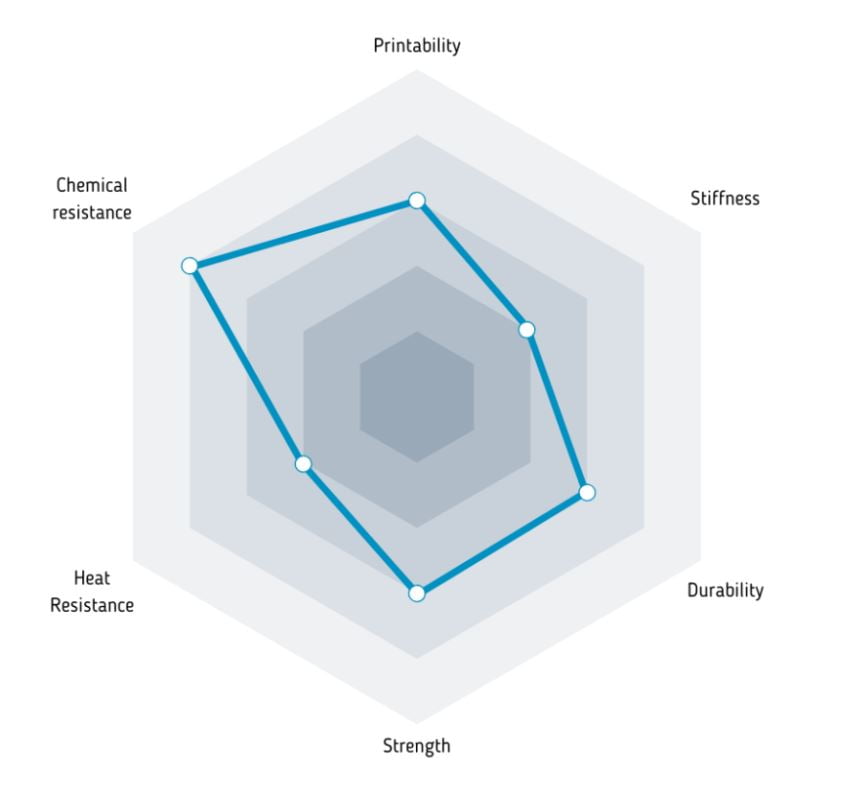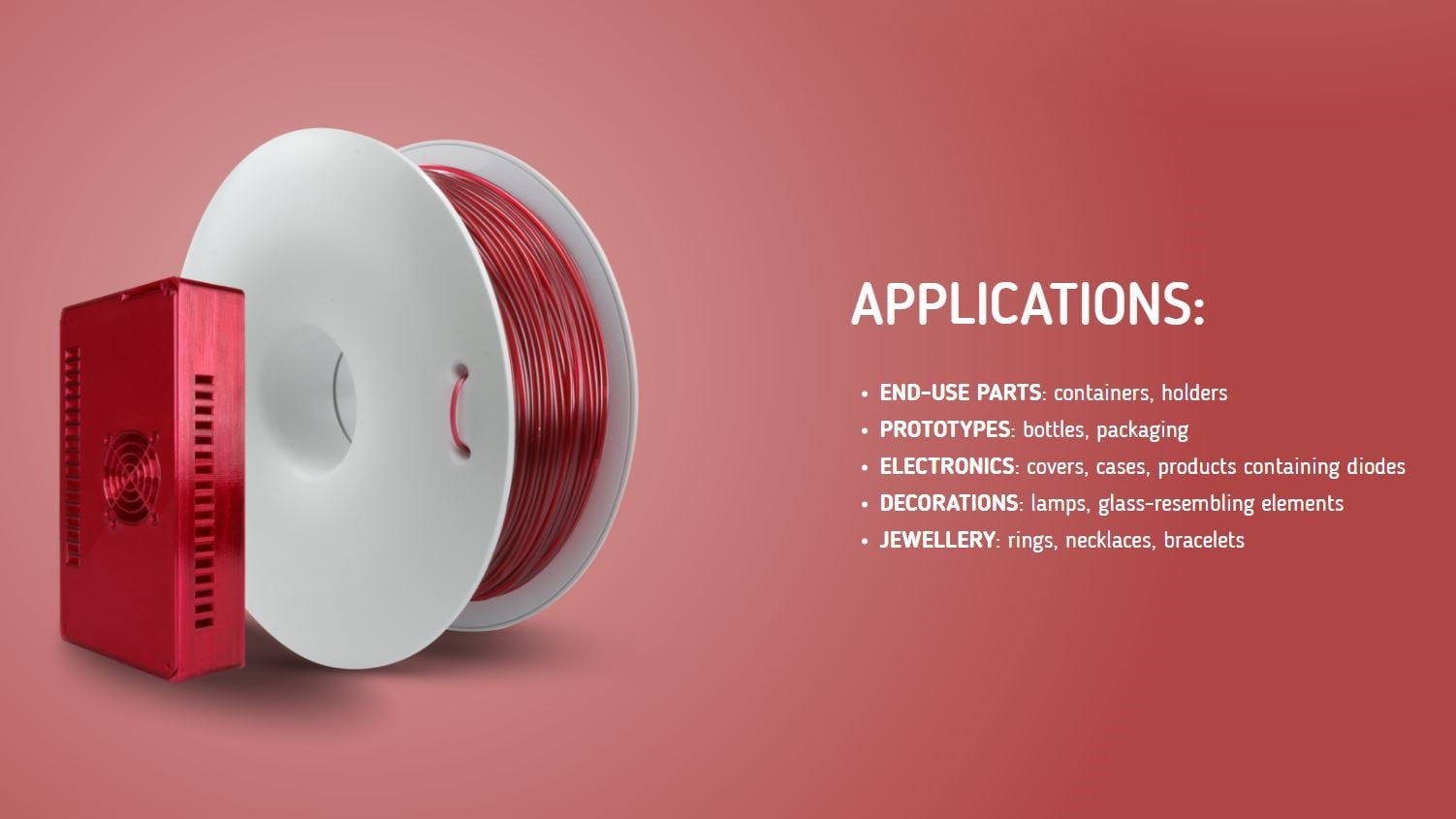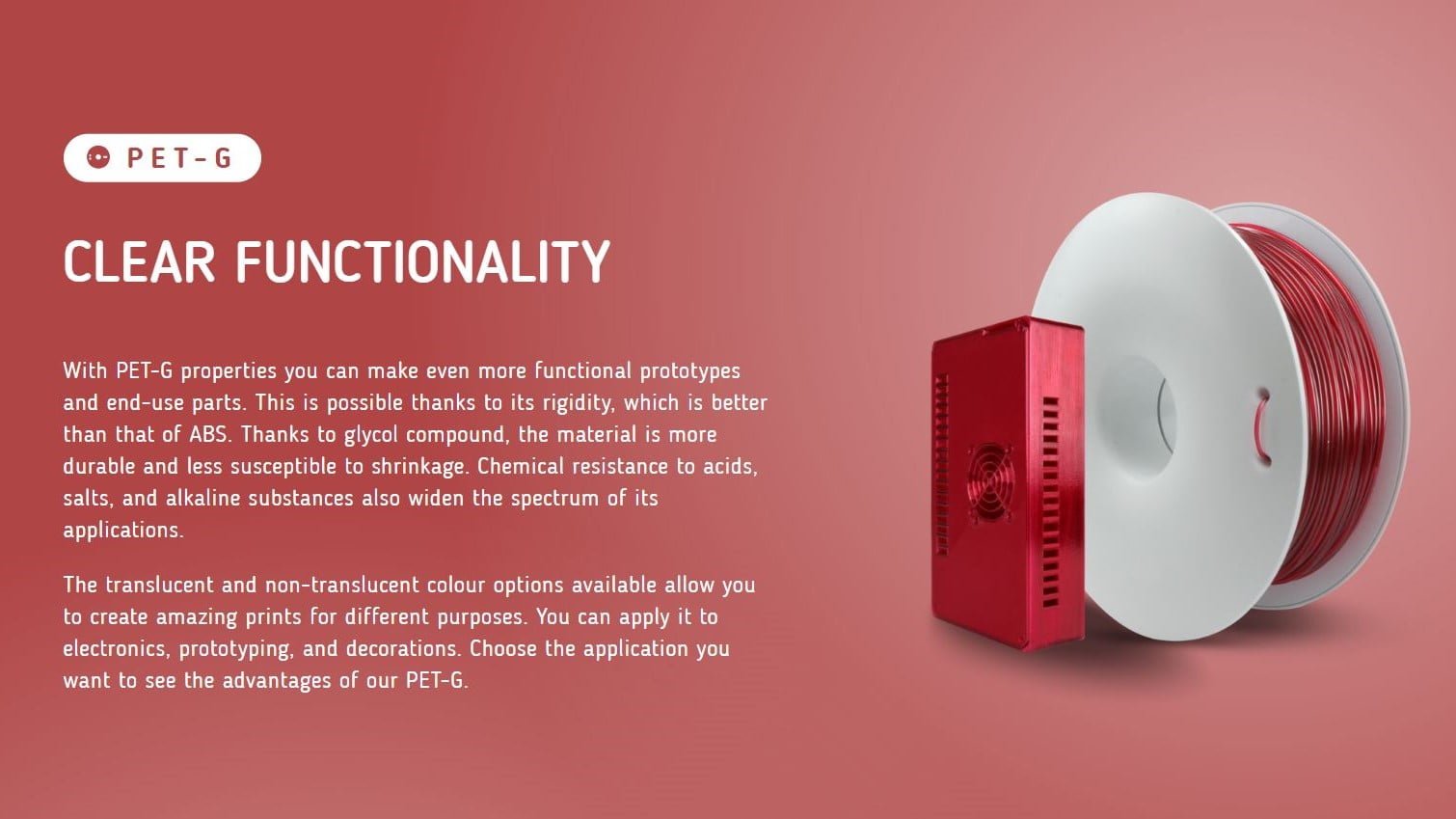O PETG da marca Fiberlogy é um material básico para impressão 3D sendo um filamento bastante durável e resistente.
As suas propriedades permitem a impressão de elementos precisos e de formas complexas, sendo que o PETG pode ser utilizado para criar protótipos funcionais, gadgets, brinquedos e objectos decorativos.
A facilidade de impressão deve satisfazer os hobbys e os utilizadores profissionais mais avançados.
PETG é diferente do EASY PETG sendo um produto que suporta temperaturas superiores sem deformar mas em contrapartida, é mais difícil de imprimir que o EASY PETG.
PETG está disponível em versões opacas e transparentes. Ambos oferecem um efeito final satisfatório e uma boa aderência entre layers.
O PETG é ideal para a impressão de modelos funcionais como de elementos decorativos.
Para obter maiores rendimentos de impressão 3D recomendamos a aplicar 3DLAC na base da plataforma.
Caso aqueças a Hotbed a 85ºC para o material PETG, consegues eliminar na totalidade todos os problemas de warpping .
Download:
Technical Data Sheet
Material Safety Data Sheet
850g - Rolo
PET-G Navy Blue - Cor
1.75mm (+-0.05mm) - Espessura / Tolerância de diâmetro
+0.01mm - Tolerância Oval
230º a 250º - Temp. recomendada do Hotend
75º a 90º - Temp. recomendada da Heated bed (mediante aplicação de 3DLAC)
Fácil - Facilidade de Impressão



O PETG da marca Fiberlogy é um material básico para impressão 3D sendo um filamento bastante durável e resistente.
As suas propriedades permitem a impressão de elementos precisos e de formas complexas, sendo que o PETG pode ser utilizado para criar protótipos funcionais, gadgets, brinquedos e objectos decorativos.
A facilidade de impressão deve satisfazer os hobbys e os utilizadores profissionais mais avançados.
PETG é diferente do EASY PETG sendo um produto que suporta temperaturas superiores sem deformar mas em contrapartida, é mais difícil de imprimir que o EASY PETG.
PETG está disponível em versões opacas e transparentes. Ambos oferecem um efeito final satisfatório e uma boa aderência entre layers.
O PETG é ideal para a impressão de modelos funcionais como de elementos decorativos.
Para obter maiores rendimentos de impressão 3D recomendamos a aplicar 3DLAC na base da plataforma.
Caso aqueças a Hotbed a 85ºC para o material PETG, consegues eliminar na totalidade todos os problemas de warpping .
Download:
Technical Data Sheet
Material Safety Data Sheet
850g - Rolo
PET-G Blue - Cor
1.75mm (+-0.05mm) - Espessura / Tolerância de diâmetro
+0.01mm - Tolerância Oval
230º a 250º - Temp. recomendada do Hotend
75º a 90º - Temp. recomendada da Heated bed (mediante aplicação de 3DLAC)
Fácil - Facilidade de Impressão



O PETG da marca Fiberlogy é um material básico para impressão 3D sendo um filamento bastante durável e resistente.
As suas propriedades permitem a impressão de elementos precisos e de formas complexas, sendo que o PETG pode ser utilizado para criar protótipos funcionais, gadgets, brinquedos e objectos decorativos.
A facilidade de impressão deve satisfazer os hobbys e os utilizadores profissionais mais avançados.
PETG é diferente do EASY PETG sendo um produto que suporta temperaturas superiores sem deformar mas em contrapartida, é mais difícil de imprimir que o EASY PETG.
PETG está disponível em versões opacas e transparentes. Ambos oferecem um efeito final satisfatório e uma boa aderência entre layers.
O PETG é ideal para a impressão de modelos funcionais como de elementos decorativos.
Para obter maiores rendimentos de impressão 3D recomendamos a aplicar 3DLAC na base da plataforma.
Caso aqueças a Hotbed a 85ºC para o material PETG, consegues eliminar na totalidade todos os problemas de warpping .
Download:
Technical Data Sheet
Material Safety Data Sheet
850g - Rolo
PET-G Onyx - Cor
1.75mm (+-0.05mm) - Espessura / Tolerância de diâmetro
+0.01mm - Tolerância Oval
230º a 250º - Temp. recomendada do Hotend
75º a 90º - Temp. recomendada da Heated bed (mediante aplicação de 3DLAC)
Fácil - Facilidade de Impressão



O filamento PLA Timberfill Cinnamon (1,75mm ou 2,85m) é um filamento de excelente qualidade fabricado na Europa para impressão 3D com o nome comercial de PLA Timberfill Cinnamon de Fillamentum.
As bobinas de 750gr de filamento PLA Timberfill Cinnamon de Fillamentum podem ser impressas facilmente em qualquer impressora 3D FFF/FDM. O PLA é um dos materiais mais utilizados em impressão 3D nos dia de hoje, como não liberta gases nocivos e é muito fácil imprimir com ele visto que não é imprescindível dispor de base de impressão quente. Se tens interesse em saber mais sobre este material podes ler maisaqui. O PLA (Ácido Polilático) é um plástico biodegradável que se obtém a partir de recursos naturais, como a partir do amido extraído do milho, da beterraba ou do trigo.
Com o filamento PLA Timberfill Cinnamon (1,75mm ou 2,85mm) é feito com mistura de material à base de madeira. A resistência é a mesma de materiais de PLA, no entanto o acabamento e toque é semelhante a madeira.
NOTA: Não recomendamos a usar um nozzle inferior a 0.5mm de diâmetro. As cores podem sofrer ligeiras alterações relativamente às fotografias.
Este filamento PLA trata-se de um filamento PREMIUM devido aos altos standards de qualidade nos que é fabricado. É fabricado por uma empresa europeia (República Checa) que destaca pela grande experiência no setor da extrusão de plásticos para indústria automotriz, química e do empacotado, destacando pela forte aposta em a investigação e desenvolvimento de novos produtos. Este é o caso dos filamentos para impressão 3D Premium Fillamentum.
O filamento PLA Timberfill Cinnamon (1,75mm ou 2,85mm) é fabricado mediante um estrito controlo ao longo de todo o processo de fabricação. Este filamento PLA Premium garante uma uma alta precisão das dimensões como são uma toleracia de diâmetro de ±0.05mm, com uma excelente circularidade e sem nenhum tipo de impurezas químicas que produzam má viscosidade do filamento. Isto se consegue além de realizando um estrito controlo em todo o processo de fabricação, utilizando uma matéria prima com a máxima pureza. Além disso oferecem-se uma grande variedade de cores segundo a sua referência RAL e Pantone dos filamentos de PLA Premium. Ao estabelecer uns altos standards de qualidade garante-se que em nenhum momento terá variações de cor pelo que nunca terás problemas de qualidade nas peças impressas em séries longas na tua impressora 3D.
Mas além disso, as bobinas de 750gr de filamento Timberfill Cinnamon (1.75mm ou 2.85mm) fabricadas por Fillamentum estão perfeitamente enroladas ou embobinadas o que evita que se produzam problemas de impressão devidos a enrolamento ou sobreposição entre sim do próprio filamento da mesma bobina.
Além de por todos os pontos mencionados anteriormente, este filamento PLA é considerado no mercado da impressão 3D como Premium devido ao seu incrível packaging com uma saca sellable de alumínio que o protege da humidade e dos raios UV e à sua vez esta no interior de uma caixa "easy open".
Por tanto, trata-se de um filamento PLA Premium de grande qualidade totalmente estabilizado para obter uns excelentes acabados com a maior fiabilidade e facilidade de impressão em 3D.
O filamento PLA é um polímero estável, permanente e inodoro. Como contrapartida do PLA em frente ao ABS cabe mencionar que a sua temperatura de amolecimento é de 60ºC em frente aos 100ºC do ABS e que as peças impressas em PLA são mais complicadas de lixar, perfurar e colar que as impressas em ABS. Se desejam-se obter acabamentos superficiais extraordinários no PLA recomenda-se a utilização do recubrimiento especificamente desenhado para impressão 3D que poderás encontrar na categoria de acessórios chamado Spray Primário de alto enchimento Berner.
Para obter maiores rendimentos de impressão 3D recomendamos a aplicar 3DLAC , que podes encontrar nos acessórios da loja.
750g - Rolo
Timberfill Cinnamon - Cor
1.75mm (+-0.1mm) - Espessura
140º a 170º - Temp. recomendada do Hotend
40º a 60º - Temp. recomendada da Heated bed
Muito Fácil - Facilidade de Impressão
O PETG da marca Fiberlogy é um material básico para impressão 3D sendo um filamento bastante durável e resistente.
As suas propriedades permitem a impressão de elementos precisos e de formas complexas, sendo que o PETG pode ser utilizado para criar protótipos funcionais, gadgets, brinquedos e objectos decorativos.
A facilidade de impressão deve satisfazer os hobbys e os utilizadores profissionais mais avançados.
PETG é diferente do EASY PETG sendo um produto que suporta temperaturas superiores sem deformar mas em contrapartida, é mais difícil de imprimir que o EASY PETG.
PETG está disponível em versões opacas e transparentes. Ambos oferecem um efeito final satisfatório e uma boa aderência entre layers.
O PETG é ideal para a impressão de modelos funcionais como de elementos decorativos.
Para obter maiores rendimentos de impressão 3D recomendamos a aplicar 3DLAC na base da plataforma.
Caso aqueças a Hotbed a 85ºC para o material PETG, consegues eliminar na totalidade todos os problemas de warpping .
Download:
Technical Data Sheet
Material Safety Data Sheet
850g - Rolo
PET-G Vertigo - Cor
1.75mm (+-0.05mm) - Espessura / Tolerância de diâmetro
+0.01mm - Tolerância Oval
230º a 250º - Temp. recomendada do Hotend
75º a 90º - Temp. recomendada da Heated bed (mediante aplicação de 3DLAC)
Fácil - Facilidade de Impressão



O PETG da marca Fiberlogy é um material básico para impressão 3D sendo um filamento bastante durável e resistente.
As suas propriedades permitem a impressão de elementos precisos e de formas complexas, sendo que o PETG pode ser utilizado para criar protótipos funcionais, gadgets, brinquedos e objectos decorativos.
A facilidade de impressão deve satisfazer os hobbys e os utilizadores profissionais mais avançados.
PETG é diferente do EASY PETG sendo um produto que suporta temperaturas superiores sem deformar mas em contrapartida, é mais difícil de imprimir que o EASY PETG.
PETG está disponível em versões opacas e transparentes. Ambos oferecem um efeito final satisfatório e uma boa aderência entre layers.
O PETG é ideal para a impressão de modelos funcionais como de elementos decorativos.
Para obter maiores rendimentos de impressão 3D recomendamos a aplicar 3DLAC na base da plataforma.
Caso aqueças a Hotbed a 85ºC para o material PETG, consegues eliminar na totalidade todos os problemas de warpping .
Download:
Technical Data Sheet
Material Safety Data Sheet
850g - Rolo
PET-G Silver - Cor
1.75mm (+-0.05mm) - Espessura / Tolerância de diâmetro
+0.01mm - Tolerância Oval
230º a 250º - Temp. recomendada do Hotend
75º a 90º - Temp. recomendada da Heated bed (mediante aplicação de 3DLAC)
Fácil - Facilidade de Impressão



O PETG da marca Fiberlogy é um material básico para impressão 3D sendo um filamento bastante durável e resistente.
As suas propriedades permitem a impressão de elementos precisos e de formas complexas, sendo que o PETG pode ser utilizado para criar protótipos funcionais, gadgets, brinquedos e objectos decorativos.
A facilidade de impressão deve satisfazer os hobbys e os utilizadores profissionais mais avançados.
PETG é diferente do EASY PETG sendo um produto que suporta temperaturas superiores sem deformar mas em contrapartida, é mais difícil de imprimir que o EASY PETG.
PETG está disponível em versões opacas e transparentes. Ambos oferecem um efeito final satisfatório e uma boa aderência entre layers.
O PETG é ideal para a impressão de modelos funcionais como de elementos decorativos.
Para obter maiores rendimentos de impressão 3D recomendamos a aplicar 3DLAC na base da plataforma.
Caso aqueças a Hotbed a 85ºC para o material PETG, consegues eliminar na totalidade todos os problemas de warpping .
Download:
Technical Data Sheet
Material Safety Data Sheet
850g - Rolo
PET-G Orange Transparent - Cor
1.75mm (+-0.05mm) - Espessura / Tolerância de diâmetro
+0.01mm - Tolerância Oval
230º a 250º - Temp. recomendada do Hotend
75º a 90º - Temp. recomendada da Heated bed (mediante aplicação de 3DLAC)
Fácil - Facilidade de Impressão



O PETG da marca Fiberlogy é um material básico para impressão 3D sendo um filamento bastante durável e resistente.
As suas propriedades permitem a impressão de elementos precisos e de formas complexas, sendo que o PETG pode ser utilizado para criar protótipos funcionais, gadgets, brinquedos e objectos decorativos.
A facilidade de impressão deve satisfazer os hobbys e os utilizadores profissionais mais avançados.
PETG é diferente do EASY PETG sendo um produto que suporta temperaturas superiores sem deformar mas em contrapartida, é mais difícil de imprimir que o EASY PETG.
PETG está disponível em versões opacas e transparentes. Ambos oferecem um efeito final satisfatório e uma boa aderência entre layers.
O PETG é ideal para a impressão de modelos funcionais como de elementos decorativos.
Para obter maiores rendimentos de impressão 3D recomendamos a aplicar 3DLAC na base da plataforma.
Caso aqueças a Hotbed a 85ºC para o material PETG, consegues eliminar na totalidade todos os problemas de warpping .
Download:
Technical Data Sheet
Material Safety Data Sheet
850g - Rolo
PET-G Light Green Transparent - Cor
1.75mm (+-0.05mm) - Espessura / Tolerância de diâmetro
+0.01mm - Tolerância Oval
230º a 250º - Temp. recomendada do Hotend
75º a 90º - Temp. recomendada da Heated bed (mediante aplicação de 3DLAC)
Fácil - Facilidade de Impressão



O PETG da marca Fiberlogy é um material básico para impressão 3D sendo um filamento bastante durável e resistente.
As suas propriedades permitem a impressão de elementos precisos e de formas complexas, sendo que o PETG pode ser utilizado para criar protótipos funcionais, gadgets, brinquedos e objectos decorativos.
A facilidade de impressão deve satisfazer os hobbys e os utilizadores profissionais mais avançados.
PETG é diferente do EASY PETG sendo um produto que suporta temperaturas superiores sem deformar mas em contrapartida, é mais difícil de imprimir que o EASY PETG.
PETG está disponível em versões opacas e transparentes. Ambos oferecem um efeito final satisfatório e uma boa aderência entre layers.
O PETG é ideal para a impressão de modelos funcionais como de elementos decorativos.
Para obter maiores rendimentos de impressão 3D recomendamos a aplicar 3DLAC na base da plataforma.
Caso aqueças a Hotbed a 85ºC para o material PETG, consegues eliminar na totalidade todos os problemas de warpping .
Download:
Technical Data Sheet
Material Safety Data Sheet
850g - Rolo
PET-G Burgundy Transparent - Cor
1.75mm (+-0.05mm) - Espessura / Tolerância de diâmetro
+0.01mm - Tolerância Oval
230º a 250º - Temp. recomendada do Hotend
75º a 90º - Temp. recomendada da Heated bed (mediante aplicação de 3DLAC)
Fácil - Facilidade de Impressão



O PETG da marca Fiberlogy é um material básico para impressão 3D sendo um filamento bastante durável e resistente.
As suas propriedades permitem a impressão de elementos precisos e de formas complexas, sendo que o PETG pode ser utilizado para criar protótipos funcionais, gadgets, brinquedos e objectos decorativos.
A facilidade de impressão deve satisfazer os hobbys e os utilizadores profissionais mais avançados.
PETG é diferente do EASY PETG sendo um produto que suporta temperaturas superiores sem deformar mas em contrapartida, é mais difícil de imprimir que o EASY PETG.
PETG está disponível em versões opacas e transparentes. Ambos oferecem um efeito final satisfatório e uma boa aderência entre layers.
O PETG é ideal para a impressão de modelos funcionais como de elementos decorativos.
Para obter maiores rendimentos de impressão 3D recomendamos a aplicar 3DLAC na base da plataforma.
Caso aqueças a Hotbed a 85ºC para o material PETG, consegues eliminar na totalidade todos os problemas de warpping .
Download:
Technical Data Sheet
Material Safety Data Sheet
850g - Rolo
PET-G White - Cor
1.75mm (+-0.05mm) - Espessura / Tolerância de diâmetro
+0.01mm - Tolerância Oval
230º a 250º - Temp. recomendada do Hotend
75º a 90º - Temp. recomendada da Heated bed (mediante aplicação de 3DLAC)
Fácil - Facilidade de Impressão


